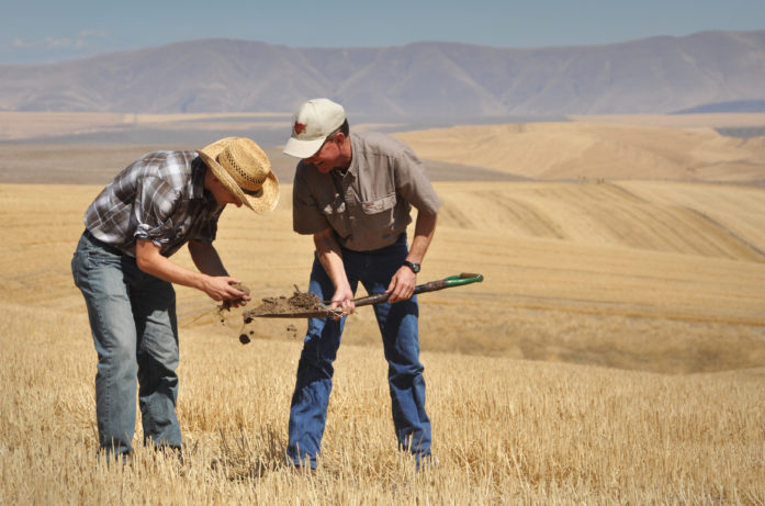Congress and the Biden administration are working on a sweeping infrastructure package known as the American Jobs Plan. This package is a once-in-a-lifetime opportunity to fix what’s broken in the United States, create good-paying jobs, combat the climate crisis and invest in rural places. In order to be truly transformative for farm country, specific investments need to be made.
Amid these debates, rural advocates (including IATP) have called for $200 billion in the coming decade to double funding for proven programs such as the Conservation Stewardship Program (CSP), incorporate innovative ideas like Climate Hubs (USDA’s regional resource centers for farmers dealing with the effects of climate change), a boost for on-farm solar and wind energy, and improve systems for local food to prevent some of the supply chain disasters we saw during the COVID-19 pandemic. We are asking for key negotiators in Washington, D.C. to incorporate the Agriculture Resilience Act (ARA) and the Climate Stewardship Act (CSA) into the agriculture title of the American Jobs Plan. The ARA increases funding and administration for existing climate and resilience-focused USDA programs like CSP and the Environmental Quality Incentives Program (EQIP). The CSA is a bolder, more transformational vision for climate and agriculture, going well beyond what the ARA calls for.
How much is $200 billion?
It can be hard to imagine what $200 billion can do to combat the climate crisis and aid farmers. In a time when existing federal conservation programs like EQIP and CSP are in high demand, a doubling of these programs is badly needed. EQIP helps farmers pay for conservation improvements on their farms such as planting grass or tree buffers between a field and a creek or planting cover crops to keep soil in place. CSP goes a step further, helping farmers implement multi-year conservation plans on their farm. For farmers who need assistance using their land to be climate stewards, CSP is the gold standard. It’s a highly popular program, especially in Minnesota, though recent changes have made it more difficult for farmers to use the program.
Despite the high demand for CSP, in the last Farm Bill, Congress decided to slowly reduce funding for the program, leaving many farmers out to dry who have relied on this program for their livelihoods and their land’s health. According to the National Sustainable Agriculture Coalition, around $1.7 billion is available for CSP in Fiscal Year 2021, over $500 million less than in FY 2019.
Looking at CSP alone, a doubling of funding could lead to a doubling of acres, a total of 16% of the United States’ farmland, or 148 million acres, would be conserved under this program. In Minnesota alone, 327,000 acres were enrolled in CSP in 2018. If we double that, an area larger than Yosemite National Park would be conserved through this program in Minnesota alone.
This increased investment could lead to more successes like Rick Story’s in Alabama. Not only did Rick improve the conservation on his farm, but he became a resource and mentor for other farmers and ranchers in his area and even turned his farm into an outdoor classroom of sorts for local university students. Scaling this program alone up could lead to a complete transformation in many farms across the country.
More jobs in rural communities
After decades of wealth concentrating in “superstar cities” such as New York, Los Angeles, San Francisco, Seattle and Washington, D.C., the rural U.S. needs good-paying, stable jobs more than ever. With any increase in conservation funding as part of a jobs/infrastructure package should come resources for county Natural Resources Conservation Service (NRCS) offices to hire technical service providers. These experts can help farmers implement the practices that make the most sense for their operation. This includes not only maximum conservation and climate benefits, but also practices that can help farmers make ends meet.
Of course, there are other ways that farms can create jobs and combat the climate crisis. Building renewable energy projects like wind and solar on farms can create jobs, provide revenue streams for farmers, and steer power grids away from dirty fossil fuels. Well-sited renewable energy projects come in many forms, including increasingly popular community solar gardens and pollinator and bird-friendly sites.
There have also been proposals for a renewed Civilian Conservation Corps (CCC), similar to the one mobilized under President Franklin Delano Roosevelt’s New Deal. There are competing ideas for whether this would be housed under USDA, the Department of the Interior or somewhere else. Regardless, any new CCC will need to atone for the racially segregated original. There is much a corps could do for conservation and climate in the U.S. With climate as the guiding principle, the new CCC could help restore wetlands on both public and private lands, reducing flooding’s risks and effects. It could help farmers and landowners install prairie strips between row crops. The options are limitless for such a program.
What happens next and how can you help?
It is hard to overstate how unique this opportunity for investment in agriculture conservation is. For decades, it has been a given that funding for anything agriculture-related would only happen once every five years through the Farm Bill. Including climate solutions through agriculture in any infrastructure package would recognize working lands for what they are — a vital resource.
The Biden administration and Congress continue to debate the merits of different infrastructure and jobs proposals. In the meantime, contacting your senators and representatives and urging them to support $200 billion in funding for agriculture in the American Jobs Plan can go a long way.
We have a chance to change the game when it comes to climate, conservation and jobs in rural America. These changes won’t solve every problem, but they can be an important step forward. Regardless, we should not pass up this opportunity for transformational change.
Teaser photo credit: Farmer with staff from the Natural Resources Conservation Service. Photo credit: USDA





